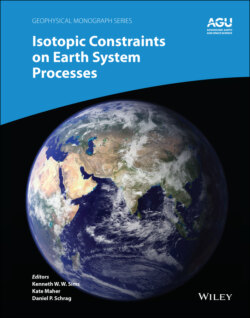Читать книгу Isotopic Constraints on Earth System Processes - Группа авторов - Страница 36
1.5.4. Fe‐Mg zoning and Fe and Mg Isotopic Fractionation in Olivine
ОглавлениеSio et al. (2013) reported iron and magnesium isotopic fractionations in a zoned olivine phenocryst from Kilauea Iki Lava Lake in Hawaii. An important aspect of this study was that it demonstrated that in the case of olivine, where the diffusive flux of one element (e.g., Mg) is balanced by an equal and opposite flux of another element (e.g., Fe), the isotopic fractionations are anti‐correlated. Two years later, Oeser et al. (2015) used femtosecond laser ablation and a multi‐collector inductively coupled plasma mass spectrometer to make a detailed study of the iron and magnesium isotopic fractionations across a number of zoned olivine xenoliths and phenocryst from various continental volcanic settings. Fig. 1.15 shows an example from their study of the Fe–Mg zoning and the anti‐correlated isotopic fractionation of iron and magnesium. Oeser et al. (2015) reported average values of β Mg = 0.08 ± 0.01 and β Fe = 0.14 ± 0.05 based on model calculations that fit the data from six olivine grains that showed the expected correspondence between the Fe–Mg zoning and the anti‐correlated iron and magnesium isotopic fractionations. Richter et al. (2016) reported similar magnesium isotopic fractionations in three olivine grains from Martian meteorite NWA 817, which were fit with β Mg = 0.13, 0.10, and 0.08, respectively. A subsequent experimental study of Fe–Mg exchange in olivine by Sio et al. (2018) determined a value of β Fe = 0.09 ± 0.05.
Figure 1.15 Chemical concentration (open circles) and isotopic fractionation (black circles with ±2 sigma error bars when larger than the symbols) measured across one edge of an olivine grain from the Massif Central, France. Note the anti‐correlation of the iron and magnesium isotopic fractionations between 0 and 400 μm.
These data are from Oeser et al. (2015).
The examples described in this section highlight the role of isotopic data as a “fingerprint” of the extent of diffusive mass transport in zoned igneous minerals pyroxene and olivine. The role of the laboratory experiments is to calibrate the “fingerprint,” which can then be used to determine the extent that diffusion is responsible for a given instance of zoning of a natural pyroxene or olivine grain. This isotopic “fingerprint” is especially important when considering whether to use the mineral zoning to determine the thermal history of the host rock.
